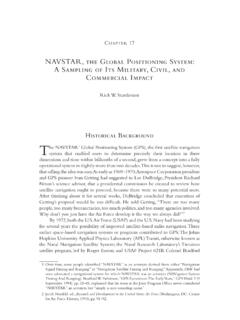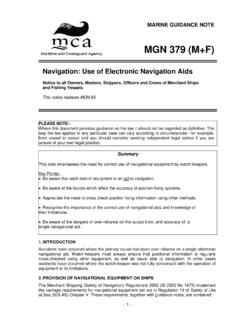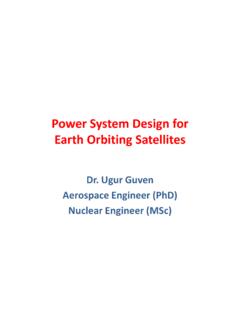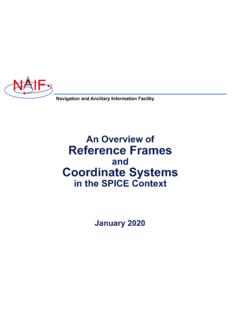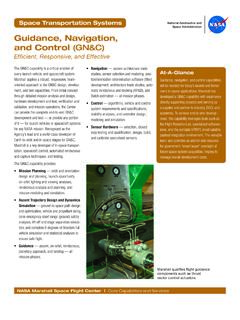Transcription of Satellite Telemetry, Tracking and Control Subsystems
1 Satellite Telemetry, Tracking and Control Subsystems Col John E. Keesee October 29, 2003 Massachusetts Institute of 1. Technology Overview The telemetry, Tracking and Control subsystem provides vital communication to and from the spacecraft TT&C is the only way to observe and to Control the spacecraft's functions and condition from the ground October 29, 2003 Massachusetts Institute of 2. Technology Outline TT&C functions and trades Command system functions Encoding/Decoding Messages Interfaces Telemetry systems Sensors and transducers ADC. Formats Concerns/Design principles October 29, 2003 Massachusetts Institute of 3. Technology TT&C Functions Carrier Tracking Command reception and detection Telemetry modulation and transmission Ranging Subsystem operations October 29, 2003 Massachusetts Institute of 4.
2 Technology Carrier Tracking Two-way coherent communication Transmitter phase-locks to the received frequency Transmitted frequency is a specific ratio of the uplink frequency Easy to find and measure the frequency received on the ground Doppler shift provides range rate October 29, 2003 Massachusetts Institute of 5. Technology Ranging Uplink pseudo-random code is detected and retransmitted on the downlink Turnaround time provides range Ground antenna azimuth and elevation determines Satellite angular location October 29, 2003 Massachusetts Institute of 6. Technology Subsystem Operations Receive commands from Command and Data Handling subsystem Provide health and status data to CD&H.
3 Perform antenna pointing Perform mission sequence operations per stored software sequence Autonomously select omni-antenna when spacecraft attitude is lost Autonomously detect faults and recover communications using stored software sequence October 29, 2003 Massachusetts Institute of 7. Technology TT&C Trades Antenna size vs transmitter power Solid state amplifiers vs traveling wave tube amplifiers Spacecraft complexity vs ground complexity October 29, 2003 Massachusetts Institute of 8. Technology TT&C Interfaces Subsystem Requirement Attitude Determination and Antenna pointing Control Command and Data Command and telemetry data rates Handling Clock, bit sync,and timing requirements Two-way comm requirements Autonomous fault detection and recovery Command and telemetry electrical interface Electrical Power Subsystem Distribution requirements Thermal/Structural Heat sinks for TWTAs Heat dissipation of all active boxes Location of TT&C subsystem electronics Clear field of view and movement for all antennas Payload Storing mission data RF and EMC interface requirements Special requirements for modulation and coding October 29, 2003 Massachusetts Institute of 9.
4 Technology Command system Reconfigures Satellite or Subsystems in response to radio signals from the ground Command timing Immediate Delayed Priority driven (ASAP). October 29, 2003 Massachusetts Institute of 10. Technology Command Functions Power on/off Subsystems Change subsystem operating modes Control spacecraft guidance and attitude Control Deploy booms, antennas, solar cell arrays, protective covers Upload computer programs October 29, 2003 Massachusetts Institute of 11. Technology Command system RF. Performance Frequencies S-band ( GHz). C-band ( GHz). Ku-band ( GHz). BER = 10-6. October 29, 2003 Massachusetts Institute of 12. Technology Spacecraft Command system Block Diagram Receiver/ Command Command Interface demodulator decoder logic circuitry Decoders reproduce command messages and produce lock/enable and clock signals Command logic validates the command Default is to reject if any uncertainty of validity Drives appropriate interface circuitry October 29, 2003 Massachusetts Institute of 13.
5 Technology Complete Command system Ground Spacecraft Support Modulation Radio Command Equipment Frequency link system GSE operator selects command mnemonic Software creates command message in appropriate format and encodes it Batch commands/macros Pulse code modulation (PCM). Phase shift keying (PSK). Frequency shift keying (FSK). October 29, 2003 Massachusetts Institute of 14. Technology Command Decoders Detects PCM encoding and outputs binary stream in non-return-to-zero format Outputs clock signal Outputs lock/enable signal Activates downstream command subsystem components Decentralized decoding reduces harness mass October 29, 2003 Massachusetts Institute of 15. Technology Secure Command Links Encryption Authentication October 29, 2003 Massachusetts Institute of 16.
6 Technology Command Message Components Input checkerboard bits Synchronization (Barker word) bits Command bits Error detection bits October 29, 2003 Massachusetts Institute of 17. Technology Command Messages Spacecraft address Command type Relay commands Pulse commands Level commands Data commands Command select Error detection and correction Multiple commands October 29, 2003 Massachusetts Institute of 18. Technology Command Logic Decodes command Validates command Correct address EDAC. Valid command Valid timing Authenticated Activates circuitry October 29, 2003 Massachusetts Institute of 19. Technology Interface Circuitry Latching relays with telltales Pulse commands Level commands Data commands Serial (enable, data and clock).
7 Parallel October 29, 2003 Massachusetts Institute of 20. Technology Telemetry Systems Measure physical properties from afar Status of spacecraft resources, health, attitude, and operation Scientific data Spacecraft orbit and timing data for ground navigation Images Tracked object location Relayed data October 29, 2003 Massachusetts Institute of 21. Technology Telemetry system RF. Performance Frequencies S-band ( GHz). C-band ( GHz). Ku-band ( GHz). BER = 10-5. October 29, 2003 Massachusetts Institute of 22. Technology Sensors and Transducers Sensors change state as a function of an external event Transducers convert energy from one form to another Outputs can be Resistance Capacitance Current Voltage October 29, 2003 Massachusetts Institute of 23.
8 Technology Signal Conditioning and Selection Conditioning ensures proper level, dynamic range, frequency response, impedance, ground reference, common mode rejection Commutation selects the proper sensor at a given time Sampling frequency determined by the Nyquist criteria October 29, 2003 Massachusetts Institute of 24. Technology Analog to Digital Conversion Converts voltages (0 v, or to v) to 2n-1 discrete values Quantization error decreases as n increases Type Conversion Word Size Power Rate High Speed 50*106 /sec 8 bit W. ADC. High Resolution 1*105 /sec 16 bit W. ADC. Low Power *104 /sec 8 bit W. ADC. October 29, 2003 Massachusetts Institute of 25. Technology Telemetry Processing Compression Analysis for autonomous systems Formatting Storage October 29, 2003 Massachusetts Institute of 26.
9 Technology Telemetry Formats Synchronization Frame count Spacecraft identification EDAC. Frame format identification Spacecraft time October 29, 2003 Massachusetts Institute of 27. Technology Multiplexing Frequency division multiple access Time division multiple access Code division multiple access October 29, 2003 Massachusetts Institute of 28. Technology Commutation in Data Formats Data type Type no. 2 bits Type Type Type no. 5 Type no. 6 bits Type no. 1 bits no. 3 no. 4 bits no. 7. bits bits bits Commutation sequential data time sampling Data includes major and minor frame identification and EDAC. Sub-commutated data given element represents different data in different frames Super-commutated data given element is found October 29, 2003 more than onceInstitute Massachusetts perofframe 29.
10 Technology Telemetry and Command system Block Diagram October 29, 2003 Massachusetts Institute of 30. Technology Command Decoder Block Diagram October 29, 2003 Massachusetts Institute of 31. Technology Data Handling Unit Block Diagram October 29, 2003 Massachusetts Institute of 32. Technology Command and Data Handling Concerns Interfaces to other Subsystems must protect the command decoder No commands or transient signals may appear on command outputs during application or removal of prime power or during under/over voltage conditions If a commands integrity is in doubt, reject it October 29, 2003 Massachusetts Institute of 33. Technology Command and Data Handling Concerns (continued).











